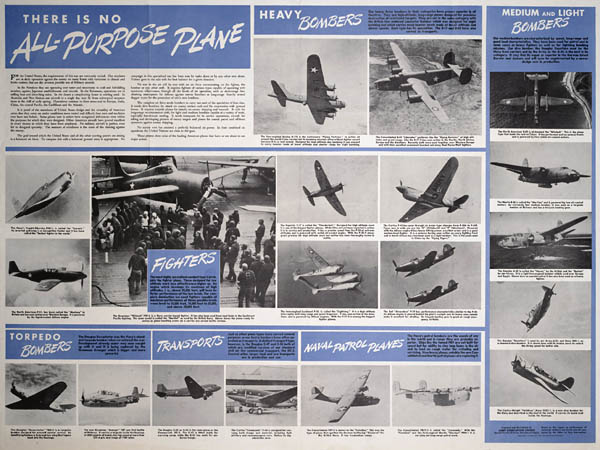“There is No All-Purpose Plane” poster from Newsmap, November 1942.
For the United States, the requirements of this war are extremely varied. Our airplanes are in daily operation against the enemy on many fronts with variations in climate and battle stations that are the severest possible test of military aircraft.
In the Aleutians they are operating over water and mountains in cold and forbidding weather, against Japanese establishments and aircraft. In the Solomons, operations are in stifling heat and drenching rains. In the desert a complicating factor is swirling sand. In Australia and New Guinea our aircraft in a single day may fly from subtropical temperatures to the chill of early spring. Operations continue in these areas and in Europe, India, China, the central Pacific, the Caribbean and the Atlantic.
It is proof of the soundness of United States design and the versatility of American crews that they carry on under conditions more varied and difficult than men and machines ever have met before. Some planes now in action have recognized deficiencies even within the purposes for which they were designed. Other American aircraft have proved excellent in every theatre in which they have been employed. No military aircraft is perfect, even for its designed specialty. The measure of excellence is the score of the showing against the enemy.
The goal toward which the United States and all the other warring powers are aiming is a balanced air force. To compare this with a balanced ground army is appropriate. No campaign in this specialized war has been won by tanks alone or by any other arm alone. Victory goes to the side with the best balance for a given situation.
No war in the air will be won with an air force concentrating on the fighter, the bomber or any other craft. It requires fighters of various types capable of operating with maximum effectiveness through all the levels of air operation, such as short-range fast-climbing interceptors for defense against enemy bombers or long-range heavily armed slugger types for the protection of one’s own bombers.
The complete air force needs bombers to carry out each of the specialties of that class. It needs dive bombers for attack on enemy surface craft and for cooperation with ground forces. It requires torpedo planes for attacks on enemy shipping and warcraft. It calls for long-range reconnaissance craft, for light and medium bombers capable of a variety of work, especially low-altitude strafing. It needs transports for its service operations, aircraft for taking and developing pictures of enemy targets and planes for coastal patrol and offshore operation against enemy shipping.
No nation ever has attained a perfectly balanced air power. In their combined air squadrons the United Nations are close to the goal.
These photos show some of the leading American planes that have or are about to see major action.











A painful lesson that the world’s air forces have to keep learning over and over again. General Dynamics F-111 Aardvark anyone?